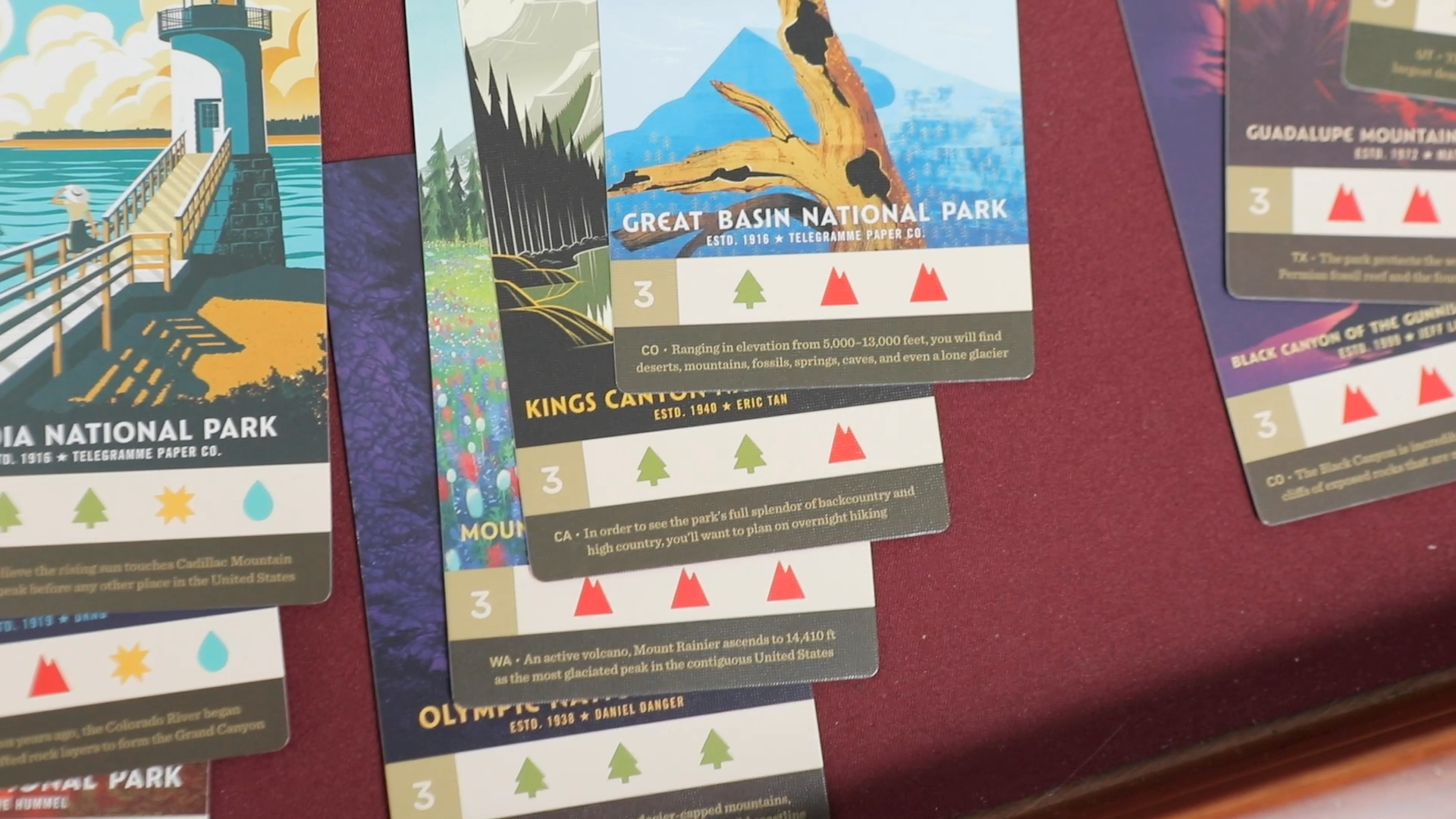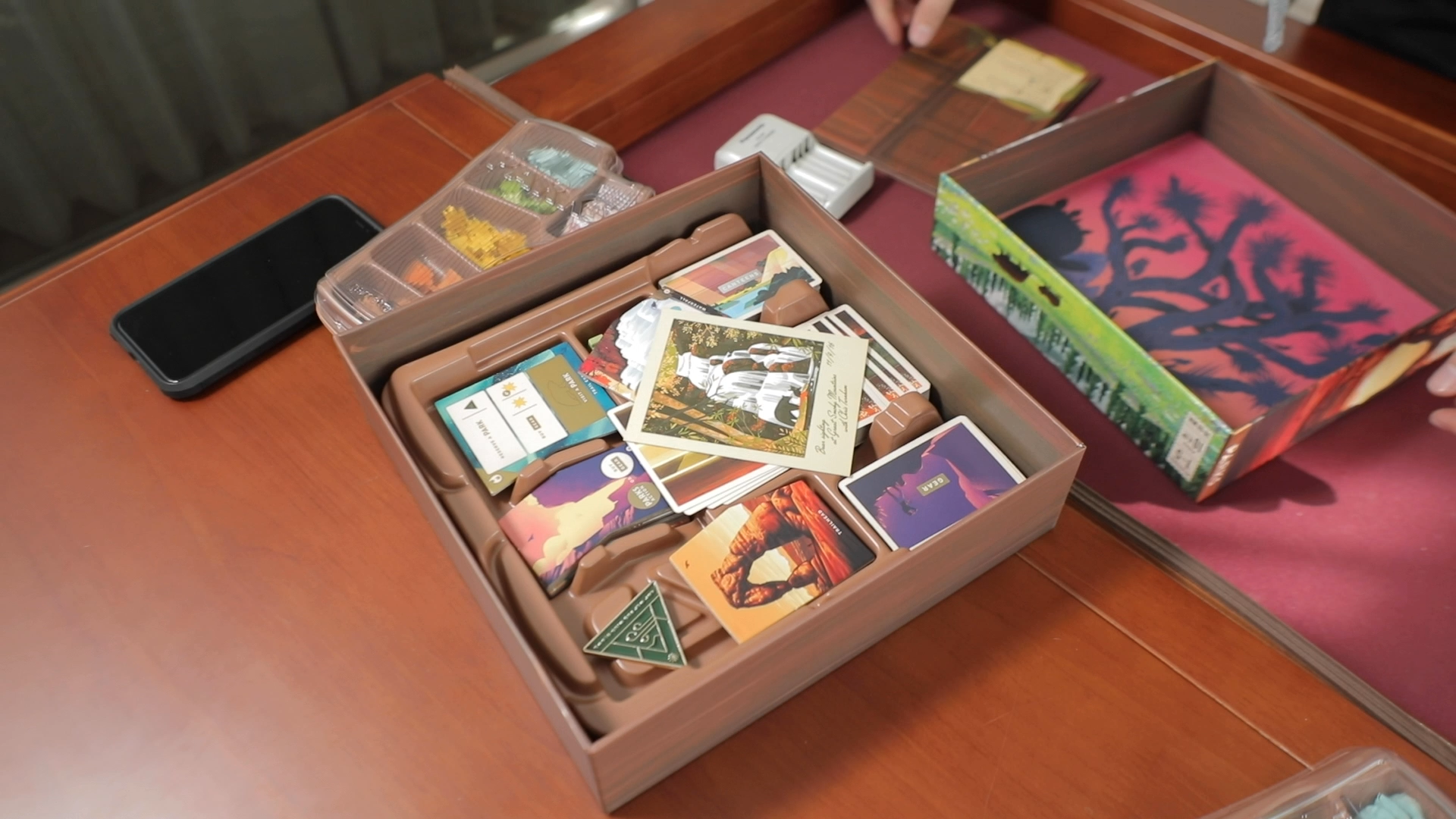Parks Review
A relaxing worker placement with some slight rondel mechanics.
Parks is the definition of a laid-back game, where players can always play at their own pace visiting tiles for resources. There’s always sites to visit and parks to see, as well as all sorts of nicknacks to spend resources on. Plays in less than an hour for 1-5 players.



Overview, How to Play, and Pros
Parks is another euro worker placement like so many others, but the gimmick that’s unique here is that the spaces you put your workers (hikers) on don’t just exist as individual spaces, but rather as places along a trail. This means everyone’s workers begins at the start of the trail, and can be placed in any space that’s forward on the trail, sort of like a rondel. However, while you can just shoot ahead to the end of the trail, you’re not gonna score well doing so since you’ve jumped past all the spaces that can give you resources.
The ultimate goal is to get the most victory points, and the biggest source is to visit a park (spend resources listed on a faceup park card to claim it). There are other minor point sources like taking pictures (spending a few resources for a point), personal objectives, and having the first player marker, but you 100% should be focusing on what park cards are out and how to get their required resources.
But because there’s only ever 3 parks out at a time—plus they get shifted out fairly often because of everyone constantly taking them—it’s surprisingly effective to just take your time, acquire a whole bunch of resources, and then just spend them on whatever happens to be available once your worker reaches the “visit a park” space. This is why Parks excels at being a super laid-back tabletop experience, because while tryharding can get you a few extra points, you can also do really well just meandering about without worrying too much about the endpoint.
And while that may seem like a bad thing, Parks is very accurate with its advertised playtime of games taking around 30 minutes to an hour, which is the perfect time frame for a more inconsequential, laidback board game experience. This means that the game was never meant to be this meticulous point grind with tons of back and forth, it’s more suited as a wind-down feels-good game where players are free to mess around for a bit and see what happens.
What really helps Parks not feel dull with this premise are its incredible components and aesthetics. Everything is mostly minimalistic and full-art, which really lets the game’s theme come to life on the table. That, and everything is really readable, and there’s never gonna be confusion over all really simple and intuitive iconography. Parks has a level of visual flair and polish that ties the whole package together and really makes it standout while playing. What’s even more amazing is that there’s an extremely functional insert and organization guide, alongside component trays for easy access during the game.
The next thing to commend is a really good level of replayability for how simple the game is. Park cards will always come out in different orders, and you won’t see most of them every game. Then the trail itself not only changes from player count, but it also has a unique tile thrown in from a pool of 4 for the game. On top of that, an actual game is split into 4 rounds (seasons), and every round the trail gets shuffled.
There’s even more factors that change your strategy round after round, game after game. It’s possible to acquire canteen and gear cards, which are essentially these permanents that give you a semblance of an engine by giving you either passive benefits, or buffing resource acquisition in unique ways. The canteens specifically make it so that whenever you acquire water, you can instead use that water to acquire the resource type that’s printed on the canteen card.
So because the trail’s changing every round, plus new gear/canteen cards are always going to be popping up, if you recall earlier how park cards are cycling out frequently as well, this ultimately ends up being a game that has a really small information horizon and a decent amount of input randomness. In other words: really high adaptability on a turn by turn basis instead of having a grander gameplay plan for the whole session. That’s the perfect formula for a game where it becomes super effective to chill out, look at the board, don’t think about it too much, and just hike to wherever seems cool at the time.
But what about how in worker placements, you can’t go the same spot as someone else? That’s here too, but if anything, people blocking spots almost serves more as a decision simplifier than an actual roadblock because of how the trail mechanics works. Plus, everyone has 2 workers anyways, so there’s always something beneficial to go on. On top of that, once per round you can go to an already occupied spot, so trying to block/deny certain spaces, parks, gear, and canteens just isn’t really going to be the way to win.
Also, the solo mode isn’t bad! It has a “ranger” deck so you as a hiker can compete against the park rangers. It has various difficulty modes, and you are able to react to what the ranger deck says they’re doing rather than having them instantly doing their actions and potentially disrupting you super hard.
Cons & Nitpicks
For the bad stuff, most of it is inconsequential production related nitpicks like slight rulebook mistakes and lack of detailed wording that fail to cover certain edge cases. That and the theme being really abstracted when interpreting it through game mechanics instead of just appreciating it for all the cool art as you play. Like, how do you even reserve a national park so that no one else can visit it? And what does collecting water, sunlight, trees, and mountains even work? Apparently, those resource tokens are supposed to represent your hikers’ memories of seeing really cool locale, but then how does generically visiting mountains and forests suddenly mean you visited, say, the Theodore Roosevelt National Park?
But when it comes to legitimate gameplay cons, the only real one is a concern of balance when it comes to how much decision making matters. Obviously, if you’re looking for a laid-back game where you can do whatever and do well, then this isn’t an issue. However, for people who are used to trying to make cool builds and utilize their tools to make sick combos happen, trying to do that here isn’t going to pan out well. A big part of this is because of how hard it is to plan ahead due to the small information horizon, but also because of how many times you’re allowed to visit parks during the game.
If one of your workers reaches the end of the trail, you can have them pick from one of three options: reserve a park, visit a park, or purchase gear. Unless you start the game with a special tile that enables visiting parks, this trail end is the ONLY way to visit parks. This means that if you try and get a crazy gear build going, you will always fall behind because you simply can’t buy enough park cards since a lot of your limited park actions went towards getting gear instead. Remember, it’s totally a thing where you can take your time on the trail, visiting as many spots as possible for a ton of resources, and then visit 2 parks with your 2 workers at the end of the round. The sweet spot when it comes to doing well with gear seems to be only getting 1-2 gear cards and only at the beginning of the game.
Final Thoughts
But other than these gripes, Parks is actually very well balanced because of its heavy usage of input randomness and constantly updating game state. If you’re looking for a light-medium euro where everyone can sit back, relax, and not think too hard about the game while taking in how gorgeous it is, Parks hits that note in strides.













